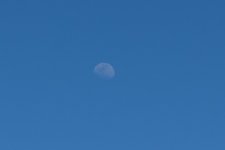Those shots are perfect examples of why I harp on processing images in Photoshop using 16-bit mode.
And, invariably, someone comes along in the thread and tells me doing that is toooootally unnecessary.
.
I guess that might be me perhaps.

But seems the wrong subject here, 16 bits is NOT going to have ANY effect on JPG artifacts. For one thing, all JPG is 8 bits.

Attempting to view 16 bit images is pointless anyway, our graphics cards and printers are 8 bits. Our histograms are 8 bits. We can never see 16 bits. We never have opportunity to even try.
Where 16 bits (or 12 or 14 bits) can help is the heroic data shifts, most notably like adding gamma. That is why cameras and scanners are 12 or 14 bits internally, to do that gamma shift. Back in early scanner days, early 8 and 10 bit film scanners did suffer. It was dynamic range, and gamma too. 12 or 14 bits was better. Raw images don't do gamma, so we output 12 or 14 bit raw, and do it in computer 16 bits. But that is something very different than routine data manipulation while editing (which already have gamma).
Once we get RGB (like JPG), then it has gamma, and is already halfway close, and we don't need heroic shifts.
This debate has a very long history, ever since Photoshop was 16 bits. Dan Margulis was at the heart of it, maybe 20+ years ago.
Dan Margulis - Wikipedia, the free encyclopedia
Dan has a very big reputation, sometimes stated as "Dan Margulis is internationally regarded as the most distinguished voice in the color correction and enhancement field." Kelby says "Dan Margulis is internationally regarded as the leading authority on color correction. He is the author of Professional Photoshop, which, since its first edition in 1994, has become the unofficial bible of the prepress and printing industries.'
Margulis writes books, including Photoshop, primarily about prepress, a gru in CMYK and correction, and one of the first three members of the Photoshop Hall of Fame. No lightweight.
Anyway, for a long time (many years), he had a standing offer to anyone that could present a real photograph negative that could be shown to benefit from 16 bit processing. This specifically excludes extreme contrived graphics work, which could be made to demonstrate it. No shortage of tries, but there was never any taker with a real photographic image. There were lesser powers that imagined Dan wrong, but the big boys pretty much went with him.
George Lucus types are indeed big on 16 bits, but that's wide screen graphics, and they have 16 bit gear.
Raw processing is already 16 bits (primarily for gamma). 16 bits for RGB can't hurt however, nothing but size and time.



